Sapphire’s Radeon HD 5850 Toxic Edition: Our First Fully-Custom 5850
by Ryan Smith on February 18, 2010 10:00 PM EST- Posted in
- GPUs
Power, Temperature, & Noise
On the one hand, by overclocking this card Sapphire has ultimately increased the power draw of the card and the amount of heat it will be generating. On the other hand with the Vapor-X cooler, they’re better equipped to siphon out that heat, and to do so without making much in the way of additional noise. So let’s see how things pan out.
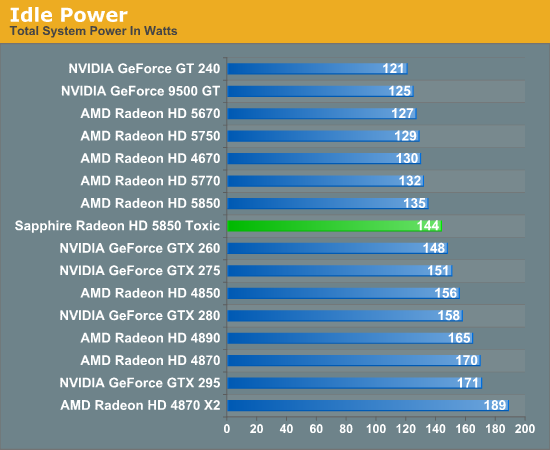
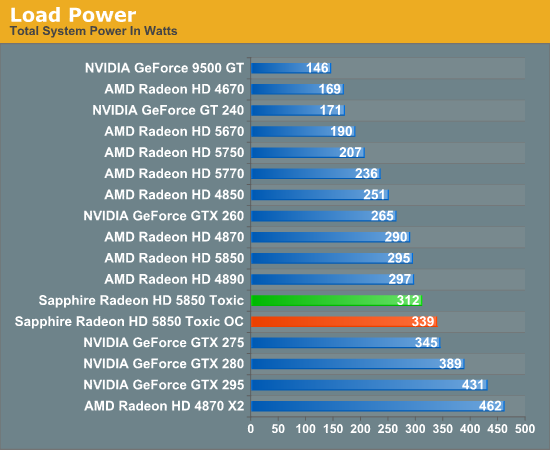
Right off the bat, the Toxic is at a disadvantage for power usage as we expected. At idle it operates at the same voltages and clocks as a reference 5850, so our 9W difference ultimately comes down to board differences; remember, the Toxic has a number of additional components compared to the reference card, particularly capacitors. Under load the difference is 17W, due to a combination of components and clock speeds. This is ultimately in-line with where you’d expect it to be based on the higher clock speeds.
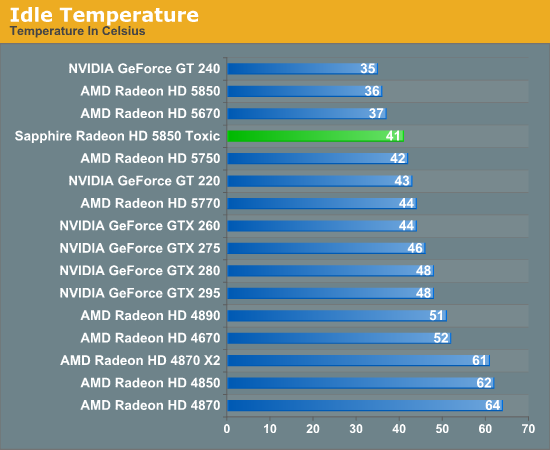
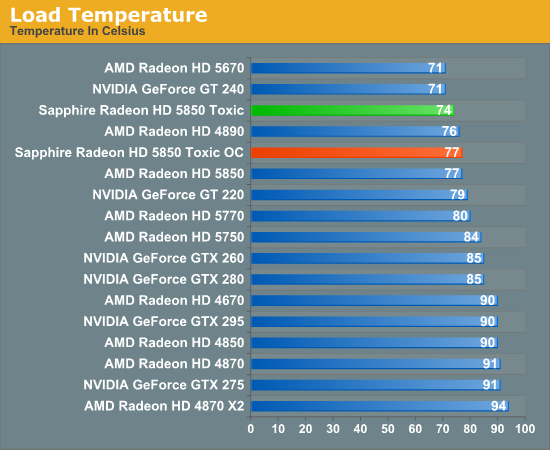
Moving to temperature, we can see the difference the Vapor-X cooler makes. The 5850 was always a particularly cool card, and surprisingly the Toxic does worse here. We’re measuring the temperature of the GPU, so any extra heat produced by the Toxic’s component selection shouldn’t be factoring in. The difference likely comes down to the coolers – a shrouded blower that fully exhausts hot air looks to be a more efficient option under these circumstances.
It’s under load where the Vapor-X cooler on the Toxic shines. Even though the card is overclocked and drawing an additional 17W, it still bests the reference cooler by 3C. It’s not a massive amount, but then again it’s only 3C warmer than even the 5670.
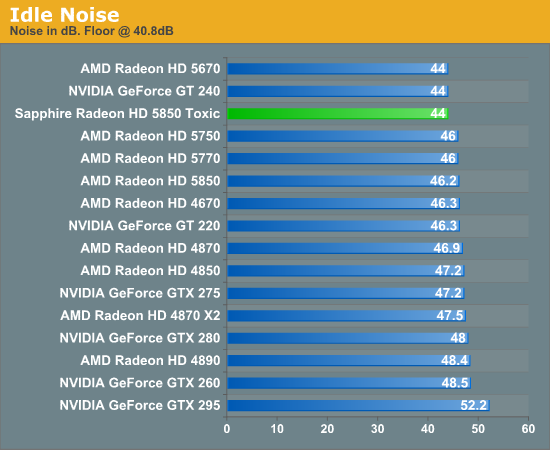
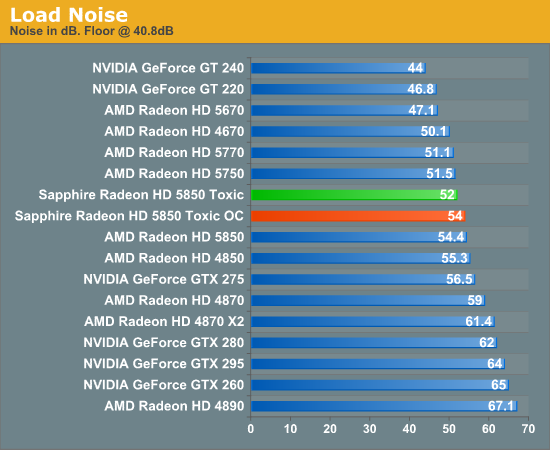
So the reference 5850 cooler may be a bit better at keeping temperatures down at idle, but it’s not the quietest option. Here the Toxic can do 2dB quieter. It’s a similar story under load, where it’s 2.4dB quieter than the reference cooler, and once again take in to consideration the fact that the Toxic is dispersing 17W of additional heat in the process.
As for our fully overclocked Toxic, the 895MHz/1175MHz clocks push power consumption up by another 27W to 339W under load. Even with the now 44W difference between it and the reference 5850, the noise generated by the Toxic and the GPU temperatures are in a dead-heat with the much slower reference 5850. There’s no question that the Toxic’s Vapor-X cooler is a superior cooler, and this leaves us wondering just how much more it can take if we could overvolt the GPU.










71 Comments
View All Comments
just4U - Friday, February 19, 2010 - link
Yeah turned out to be Java:selace ... Don't know where the hell I could have picked it up from. Ah well cleaned after a full check.7Enigma - Friday, February 19, 2010 - link
It's not from Anand's site, though I've gotten that at work from another site which resulted in a hosed system (they use an old version of IE without popup blocker and won't let 3rd party browsers be used...).just4U - Friday, February 19, 2010 - link
I am using IE8 here with all security patches in play. Going to do a full scan with Malwarebytes and MS SecurityE and see if they pick anything up.. just did quick scans afterall.It bypassed the popup blocker initially and showed a small prompt on screen saying I may be infected. Closing and canceling had no effect as it still re-routed my browser to a look-alike Vista control panel type page.
7Enigma - Friday, February 19, 2010 - link
Please in the future when testing a factory overclocked card highlight the STOCK card in the graphs. It's frustrating to constantly hunt through the cards in each chart to see the difference between the stock 5850 and the Sapphire card.Thanks.
legoman666 - Friday, February 19, 2010 - link
You mention an overdrive clock limit of 775. My 5850 is currently running at 825 overclocked via CCC. It goes even higher; somewhere around 900. Why are you using the 9.9s when the 10.2's are available? Maybe that's why your overclock is so limited.Ryan Smith - Friday, February 19, 2010 - link
It's not a driver issue. The OD limit is hardcoded in to the BIOS. My reference 5850s have the same 775/1125 limit.What 5850 do you have? None of them should be shipping with a higher overdrive limit from what AMD tells me.
legoman666 - Sunday, February 21, 2010 - link
http://i28.photobucket.com/albums/c241/legoman666/...">http://i28.photobucket.com/albums/c241/legoman666/... @ 825legoman666 - Sunday, February 21, 2010 - link
http://i28.photobucket.com/albums/c241/legoman666/...">http://i28.photobucket.com/albums/c241/legoman666/...I have an Asus EAH5850. It's at stock clocks in the pic, but I've had it up to ~880.
Barneyk - Friday, February 19, 2010 - link
That was a bit strange to me. The card keeps most of the heat dissipated from the card in the case and it produces more heat then a standard 5850.So if you have a very well-ventilated case I guess its not an issue but what if you dont?
Would you still recommend it?
erple2 - Friday, February 19, 2010 - link
I don't think that he mentions what portion of the heat the Toxic vents into vs. out of the case. However, it would stand to reason that a well-ventilated case would be important either way.That does bring up an interesting point, however, that may be outside of the scope of this article. I'm assuming that all of the testing is done in a well-ventilated case. If the temperatures inside of the case were sufficiently high enough, it would start to impact the temperature of the card significantly. Given that the Toxic runs "cooler" than the stock card, one of two things is true:
1. The recirculating temperature problem is a non-issue
2. The case Ryan uses is well ventilated and thus the temperature problem is a non-issue.
The conclusion, then, is that it's a non-issue. However, who, buying an enthusiast card like this for 300+ dollars, doesn't have a well-ventilated case? I suppose that there are people out there that don't. Perhaps an investment in a quality case would be in order? At least, case performance takes a long time to become obsolete (unlike, for example, video cards).